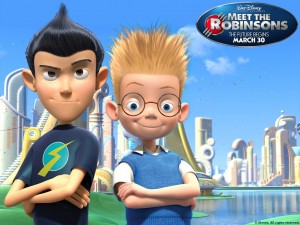Growing up, I wanted to be an inventor.
I think it started with my Mom giving me a copy of Jules Verne’s 20,000 Leagues Under the Sea, saying, “I think you’ll like this.” Did I ever. I devoured Verne and H.G. Wells, then moved on to more modern SF literature.
I was attracted to the role of the inventor, always coming up with new inventions. I knew it wouldn’t be as simple as it was in the cartoons I watched (“Today, I’ve invented a shrinking ray!”). But I loved the idea of playing around with technology.
That’s probably why I was so attracted to programming when I got a computer a couple years later. With software, I wasn’t limited by physics or natural laws; I could make just about anything happen. I never got into the hardware or electrical side of things, something I now mildly regret.
 Which is why I was initially attracted to the trailer for Disney’s Meet the Robinsons, a CGI feature from several years ago. It had some odball humor — like the Tyrannosaurus Rex villain complaining about his stubby, useless arms — and a kid inventor protagonist. But I was worried that the kid would be a Jimmy Neutron
Which is why I was initially attracted to the trailer for Disney’s Meet the Robinsons, a CGI feature from several years ago. It had some odball humor — like the Tyrannosaurus Rex villain complaining about his stubby, useless arms — and a kid inventor protagonist. But I was worried that the kid would be a Jimmy Neutron
That’s not Meet the Robinsons. Lewis, the protagonist, is a deeply conflicted 12-
Those become the film’s themes: failure and identity. What is failure? And are we determined by our genes or our choices?
In my opinion, this is a
This flick grabbed me. Lewis is instantly likable, from his love of technology to his passion for invention and improving the world. He’s a kid, which a lot of kids’ films seem to forget about. He’s innocent without being naïve.
He also genuinely hurts. He’s not a genius adventurer; he’s a flawed boy, who is also a genius and goes on an adventure. There’s a huge difference, and it’s a hallmark of
I’ve long said that Disney animators could animate rocks effectively, and Meet the Robinsons proves it. Despite being relatively unfamiliar with CGI, the animators bring emotion and reality to the characters. For example, during a scene with one primary character, secondary characters react and go through their own emotional arcs while in the background. And they don’t follow familiar facial reactions.
Note: Brad Bird, director of The Incredibles, was once asked to identify the biggest strength and the biggest weakness of the newest generation of animators. He replied that it was the same thing: we have decades’ worth of animation that we can study, and it can be done by pausing DVDs at its simplest level. But that study can lead to imitation. He described watching current animated films and saying to himself, “Okay, there’s walk #5, and there’s shocked expression #3, and there’s grin #6.”
Now, John Lasseter was heavily involved with this film, and according to IMDb was responsible for reshoots on 60% of the footage. But those were larger creative directions for the story, not directives for individual animators. This film demonstrates tremendous craft.
And the story’s inspirational. It’s about simple truths, told in a way that’s affecting, memorable, beautiful, and touching. I teared up at the end, because the end celebrated the tremendous potential of humanity.